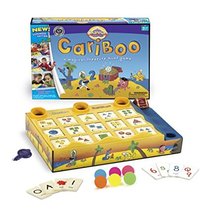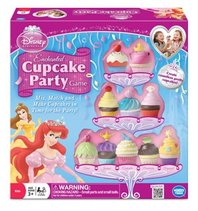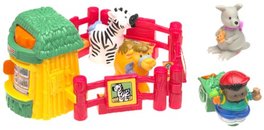It’s time again for our monthly segment: Favorite Toys Without Batteries! As we talked about in this post, we love toys without batteries. Below is The Speech Space’s March list of great toys that don’t make noise– so that you can get your child talking more while you’re playing!

1. Cariboo: One of our favorite games ever! In this game, you hide balls below an array of boxes with pictures of different objects. When you find all of the balls, the treasure chest opens– like magic! This game is great because you can target language in so many different ways. A few ways you can play this game: have your child open boxes based on color, category, number of objects, or even give multiple descriptions to work on their understanding of complex sentences (e.g., “Open the box with a green vehicle that can fly.”)

2. Disney Princess Cupcake: We always modify games when needed, and this one is no exception. There are two main ways we like to play this game to maximize working on language skills. The first way to play with your child would be to separate all cupcake pieces and then tell your child the “recipe” (from the recipe cards) or have your child give you the recipe to create your cupcakes. The second way you can play is by tossing the recipe cards and letting your child get creative by telling you how they want to make the cupcakes. This game is great for increased descriptive language (e.g., “I want the blue wrapper, tall chocolate cake, the yellow and white frosting and the pink flower topper.”) and following directions.
3. Dramatic Play: Dramatic play is wonderful for increasing language in children. It’s especially important for them to pretend with materials that they may or may not have experienced yet, but possibly will encounter. Doctors kits (check out this one), kitchen sets (like this one), camping and/or fishing equipment, grocery store carts and items, and restaurant toys (aprons, pretend bills, etc) are all great things for kids to get used to by pretending with them before experiencing them in real life.

4. Little People: The Fisher Price Little People were toys we played with growing up. They’re great for targeting pronouns (e.g., he/she, his/her), descriptions (e.g., “The girl who is holding a bird.”), prepositions (e.g., “Put the boy under the table.”), and actions (e.g., “He’s swinging and she will slide.”). Again, imaginative play is so very important for your child’s language development! Imaginative play with fun toys can help expand your child’s language in a structured environment while you help scaffold and expand their utterances.
5. Box of fun: This is totally made up and you can throw anything in! Think of putting in an assortment of small, unique toys your child may find interesting. Some of our boxes have a variety of windup toys (you can get a large bag on Amazon for under $15), bubbles, accordion tubes, silly putty, a spinning light up toy— basically a bunch of weird, silly, fun things! Have your child request items by function or description or name them, they can request help using specific nouns and verbs ( e.g., “Can you help me wind up with monkey toy?”), or they can talk to you about how each thing works or feels. Cheap and easy fun is the best!These are just a few more our favorite toys and ideas. If you missed last month’s segment on our favorite toys without batteries, you can see it here! Check back on The Speech Space blog for other fun ideas, toys and games you can do with your child to help increase their language and communication development.
And as always, if you have questions or concerns about your child’s speech and language, contact us at The Speech Space!
